Viola fimbriatula Sm.
Common names:
Northern Downy Violet, Ovate-leaved Violet
Synonyms:
Viola fimbriatula Sm., in Rees, Cycl. 37: 16. 1817. TYPE: North America, "dry hills from Canada to Virginia", 1817, F. Boott s.n. (holotype: Herb. Smith no. 1380.11, LINN, JSTOR Global Plants image!; photo: MICH).
Viola sagittata Aiton f. umbelliflora (Fernald) Scoggan, Fl. Canada pt. 1: 52. 1978; Viola fimbriatula Sm. f. umbelliflora Fernald, Rhodora 51: 56. 1949
Viola fimbriatula Sm. f. glabrata Pennell, Bartonia 12: 19. 1931
Viola fimbriatula Sm. f. albescens Farw., Amer. Midl. Naturalist 11: 66. 1928
Viola amorphophylla Pollard, Proc. Biol. Soc. Washington 13: 129. 1900
Viola ovata Nutt. var. hicksii (Pollard) Pollard, Proc. Biol. Soc. Washington 10: 92. 1896; Viola sagittata Aiton var. hicksii Pollard, Bot. Gaz. 20: 326. 1895
Viola sagittata Aiton var. ovata (Nutt.) Torr. & A.Gray, Fl. N. Amer. 1(1): 138. 1838; Viola ovata Nutt., Gen. N. Amer. Pl.: 148. 1818
Viola ovata Nutt. var. belvisiana Ging., in DC., Prodr. 1: 294. 1824
Viola alleghanensis Schult., Syst. veg. 5: 360. 1819
Viola primulifolia Pursh, Fl. Amer. sept. 1: 173. 1813
Description:
Acaulescent rosulate perennials from thick rhizome, ≤ 19 cm tall; foliage and peduncles green (lower surface of leaf blades occasionally tinged purple), densely hirtellous; subheterophyllous, at least the outer leaves spreading or prostrate, leaf blades during chasmogamous flower undivided, in fruit often with 1–2(3) short coarse apically oriented basal teeth on each side; stipules free, irregularly glandular-fimbriate; largest leaf blades ≤ 80 × 30 mm, oblong-ovate to narrowly ovate, in summer becoming ovate-triangular, base truncate to subcordate, margins crenate, ciliate, apex acute to obtuse; chasmogamous peduncle held above the leaves; chasmogamous flower ≤ 20 mm; calyx glabrous, ciliate; lowest sepals ovate-lanceolate to ovate, acute; auricles short to somewhat prominent and entire, elongating to 4 mm in fruit and becoming erose; corolla blue to purple, throat white; spur short-globose; lateral petals densely bearded with filiform hairs, spurred petal densely bearded; cleistogamous flowers produced after chasmogamous, the peduncle declined and shorter than or equaling petioles; capsule 7–11 mm, green drying tan, unspotted, glabrous; seeds 1.3–1.9 × 0.8–1.3 mm, medium to dark brown or gray-brown, unspotted or with small weak darker blotches; 2n=54.
Similar species:
The distinctive habit of the spreading to prostrate leaves in living plants of this species, recalling a primrose rosette, and the proportionally short(er) petiole relative to the leaf blade distinguish it from the most similar species Viola emarginata and Viola sagittata in the Sagittata species group, which also share the densely spurred petal, sharply acute sepals, prominent elongating auricles, and unspotted cleistogamous capsules. It shares winged petioles with Viola emarginata, but differs from Viola emarginata and Viola sagittata in its densely hirtellous foliage and chasmogamous peduncles, ciliate sepals, and declined cleistogamous peduncle. Young flowering plants of this are sometimes troublesome to separate from midwestern V. sagittata, given that the commonest phenotype in the latter exhibits sparsely to moderately hirtellous foliage and sometimes sparsely hirtellous peduncles and sparsely ciliate sepals; however, the erect leaf habit, proportionally longer petioles, and absence of prominent petiole wings in V. sagittata will separate the two. It could also potentially be mistaken for V. grisea, a northern Great Lakes species, if the distinctive "primrose-rosette" is ignored, differing in its winged petioles, sharply acute sepals, prominent elongating auricles, and unspotted cleistogamous capsule on a declined peduncle.
Ecology:
Somewhat acidic, well-drained sandy and gravelly soils in glades, prairie openings in oak barrens and savannas, and on sparsely vegetated slopes of oak forests; sometimes persists in droughtier microsites of old pastures and other areas that were former barrens and prairies.
Distribution:
Restricted to higher elevations of the Appalachian Mountains and associated uplands, and at lower elevations in the s. Great Lakes region, NS? and ME to s. MI, south to w. NC, se. TN, and ne. OH, slightly disjunct in sw. WI.
Rarity:
State listed in WI.
Phenology:
Chasmogamous flower April–May, chasmogamous fruit May–June, cleistogamous fruit July–September.
Affinities:
This species belongs to the Acaulescent Blue Violet lineage, sect. Nosphinium W.Becker, subsect. Boreali-Americanae (W.Becker) Gil-ad, in the Sagittata species group.
Hybrids:
Hybridizes with V. affinis (Dowell 1910, Brainerd 1924, Haines et al. 2011), V. baxteri (House 1917, 1924, Brainerd 1924 in part), V. brittoniana (Pollard 1902, Brainerd 1906b, 1907a, 1924, Haines et al. 2011), V. communis [or possibly V. "sororia glabrous" or V. "sororia hirsutula-like"] (Stone 1903, Brainerd 1904b, 1906b, 1924, House 1924), V. cucullata (Brainerd 1904b, 1905, 1924, Henry 1953a, Haines et al. 2011), V. emarginata sensu stricto (Brainerd 1906b, 1924, House 1924, Harvey Ballard pers. comm.), V. hirsutula (Dowell 1910, Brainerd 1924, Henry 1953a), V. latiuscula (Brainerd 1924, House 1924), V. palmata var. triloba (Brainerd 1906b, 1924, Haines et al. 2011), V. sagittata (Greene 1898, Pollard 1898, Brainerd 1906b, 1907a, 1924, House 1924, Cinq-Mars 1966, Haines et al. 2011), V. septentrionalis (Brainerd 1904b, 1905, 1924, House 1924), V. sororia sensu stricto (Brainerd 1904b, 1924, House 1924, Henry 1953a, Haines et al. 2011), and V. subsinuata sensu stricto (Brainerd 1913c, 1924, House 1924, Haines et al. 2011). Brainerd reported that these exhibit intermediate or recombinant characteristics of foliage, chasmogamous flowers, cleistogamous capsules and seeds (where these did not abort). All hybrids fail to reproduce by chasmogamous flowers. Many hybrids produce abortive cleistogamous flowers or capsules, while most others generate a substantially to highly reduced proportion of viable seeds. Hybrids involving V. emarginata and V. sagittata are more variable, some plants nearly sterile and others nearly fully fertile in their viable seed output.
Comments:
Brainerd (1921b), Brainerd Baird (1942), Fernald (1950), Henry (1953a), Alexander (1963), Gleason and Cronquist (1963), Russell (1965), and Strausbaugh and Core (1978) recognized V. fimbriatula at species rank. McKinney (1992), Ballard (1995, 2000), Voss and Reznicek (2012), Weakley et al. (2012), and Little and McKinney (2015) demoted it to V. sagittata Aiton var. ovata (Nutt.) Torr. & A.Gray, while Gleason and Cronquist (1991) synonymized it under V. sagittata. Gil-ad (1995, 1997, 1998) documented unique macromorphological features and consistent micromorphological differences in petal trichomes. However, he noted that micromorphological features of the seed coat were similar in many respects to V. sagittata and could not be used to support species status separate from the latter. He tentatively maintained V. fimbriatula as a species pending further studies testing a hypothesis of hybrid speciation involving V. sagittata and another unidentified species. Gil-ad also pointed out that at least some plants studied ecologically under the name of this species were probably hybrids of V. fimbriatula and V. sagittata. This is true of studies by Yost (1987) to examine effects of light on petiole length, as the photographs of living plants subjected to environmental treatments diverge from V. fimbriatula in several vegetative and reproductive traits. This species can easily be distinguished from V. sagittata (including commonly sparsely to moderately hirtellous plants which have caused confusion in the Midwest) by its primrose-like habit of the rosette, in which at least the outer widely spreading or lying prostrate on the substrate (typically all of them during cleistogamous fruit), proportionally short winged petioles, densely hirtellous indumenta, ciliate sepals, coarse basal teeth on leaf blades of summer fruiting plants, and declined cleistogamous peduncles (Gil-ad designated these as “prostrate”, but in several typical populations over the range of this taxon I have observed them to be declined rather than horizontal). The macromorphology of the seeds is subtly different, and its typical habitats are more xeric and soils are more gravelly than is usual for V. sagittata. Moreover, Gil-ad’s documentation of consistent micromorphological differences from V. sagittata in the petal trichomes and in the seed coat (regardless of suggestions of hybrid origin) provide additional evidence that it is not conspecific with V. sagittata. Rare glabrous plants or populations have been collected in the Appalachian Mountains but they are otherwise identical to typical V. fimbriatula. A peculiar leaf morph described from Tryon, North Carolina with the main axis of the blade lanceolate, bearing a basal elongated process on each side, has been named V. amorphophylla Pollard and was discussed at length by Brainerd (1911a). Although distinctive and peculiar in blade dissection, it is identical in all other respects to typical V. fimbriatula and included without formal recognition. The range of the species is primarily Appalachian but extends into the southwestern Great Lakes region through northern Ohio and southern Ontario to southern Michigan, then is slightly disjunct in the “Driftless Area” of southwestern Wisconsin. It ranges northeastward into New England and adjacent Canada, where V. sagittata is virtually absent.
Literature Cited:
Alexander, E. J. 1963. Violaceae. In Gleason, H. A., The new Britton and Brown illustrated flora of the northeastern United States and adjacent Canada. Hafner Publishing Co., Inc., New York, NY. 552-567.
Ballard Jr., H. E. 1995 ["1994"]. Violets of Michigan. Michigan Botanist 33: 131-199.
Ballard Jr., H. E. 2000. Violaceae. In Rhoads, A. (ed.). Flora of Pennsylvania. University of Pennsylvania Press, Philadelphia, PA. 700-710.
Brainerd, E. 1904b. Hybridism in the genus Viola. Rhodora 6: 213-223, plate 58.
Brainerd, E. 1905. Notes on New England violets,-II. Rhodora 7: 1–8, Plate 50.
Brainerd, E. 1906b. Hybridism in the genus Viola,-III. Rhodora 8: 49-60, plates 66-70.
Brainerd, E. 1907a. The behavior of the seedlings of certain Viola hybrids. Science 25: 940-944.
Brainerd, E. 1911a. Further notes on the stemless violets of the south. Bulletin of the Torrey Botanical Club 38: 1-9.
Brainerd, E. 1913c. Notes on new or rare violets of northeastern America. Rhodora 15: 112-115.
Brainerd, E. 1921b. Violets of North America. Vermont Agricultural Experiment Station Bulletin 224: 1–172.
Brainerd, E. 1924. The natural violet hybrids of North America. Vermont Agricultural Experiment Station Bulletin 239: 1-205.
Brainerd Baird, V. 1942. Wild violets of North America. University of California Press, Berkeley, CA.
Cinq-Mars, L. 1966. Mise au point sur les violettes (Viola spp.) du Québec. Naturaliste canadien 93: 895–958.
Dowell, P. 1910. The violets of Staten Island. Bull. Torr. Bot. Club 37: 163-179, pl. 11-18.
Fernald, M. L. 1950. Violaceae. In Gray’s Manual of Botany, 8th ed. American Book Company, New York, NY. 1022-1042.
Gil-ad, N. L. 1995. Systematics and evolution of Viola L. subsection Boreali-Americanae (W. Becker) Brizicky. Ph.D. dissertation. University of Michigan, Ann Arbor, MI.
Gil-ad, N. L. 1997. Systematics of Viola subsection Boreali-Americanae. Boissiera 53: 1–130.
Gil-ad, N. L. 1998. The micromorphologies of seed coats and petal trichomes of the taxa of Viola subsect. Boreali-Americanae (Violaceae) and their utility in discerning orthospecies from hybrids. Brittonia 50: 91–121.
Gleason, H. A., and A. Cronquist. 1991. Violaceae. In Manual of vascular plants of northeastern United States and adjacent Canada, 2nd ed. New York Botanical Garden, Bronx, NY. 157-163.
Greene, E. L. 1898c. New or noteworthy violets. Pittonia 3: 313-318.
Haines, A., E. Farnsworth, and G. Morrison. 2011. Violaceae. In Flora Novae Angliae. Yale University Press, New Haven, CT. 873-886.
Henry, L. K. 1953a. The Violaceae in western Pennsylvania. Castanea 18(2): 37-59.
House, H. D. 1917. Local flora notes IV. New York State Museum Bulletin 197: 52-60.
House, H. D. 1924. Annotated list of the ferns and flowering plants of New York state. Family 83 Violaceae. New York State Museum Bulletin 254: 499-512.
Little, R. J., and L. E. McKinney. 2015. Violaceae. In Flora of North America: Cucurbitaceae to Droseraceae, 106. Oxford University Press, New York, NY.
Henry, L. K. 1953a. The Violaceae in western Pennsylvania. Castanea 18(2): 37-59.
McKinney, L. E. 1992. A taxonomic revision of the acaulescent blue violets (Viola) of North America. Sida, Botanical Miscellany 7: 1–60.
McKinney, L. E., and N. H. Russell. 2002. Violaceae of the southeastern United States. Castanea 67: 369–379.
Pollard, C. L. 1898. Further observations on the eastern acaulescent violets. Botanical Gazette 26: 325-342.
Pollard, C. L. 1902. Two new violets from the eastern United States. Proceedings of the Biological Society of Washington 15: 201-203.
Russell, N. H. 1965. Violets (Viola) of the central and eastern United States: An introductory survey. Sida 2: 1-113
Scoggan, H. J. 1978. Violaceae. In Flora of Canada, Part 3–Dicotyledoneae (Saururaceae to Violaceae). National Museums of Canada. Ottawa, Canada. 1103-1115.
Stone, W. 1903. Racial variation in plants and animals with special reference to the violets of Philadelphia and vicinity. Proceedings of the Academy of Natural Sciences of Philadelphia 55: 656-699, plates 31-39.
Strausbaugh, P. D., and E. L. Core. 1978. Violaceae. In Flora of West Virginia, 2nd ed. Seneca Books, Inc., Morgantown, WV. 644-658.
Swink, F., and G. Wilhelm. 1979. Violaceae. In Plants of the Chicago region, 2nd ed. revised and expanded. Morton Arboretum, Lisle, IL. 384, 801-810.
Voss, E. G., and A. A. Reznicek. 2012. Violaceae. In Field manual of Michigan flora. The University of Michigan Press, Ann Arbor, MI. 913-922.
Weakley, A. S., J. C. Ludwig, and J. F. Townsend. 2012. Violaceae. In Flora of Virginia. BRIT Press, Fort Worth, TX. 963-975.
Yost, S. E. 1987. The effect of shade on petiole length in the Viola fimbriatula-sagittata complex. Brittonia 39: 180–187.
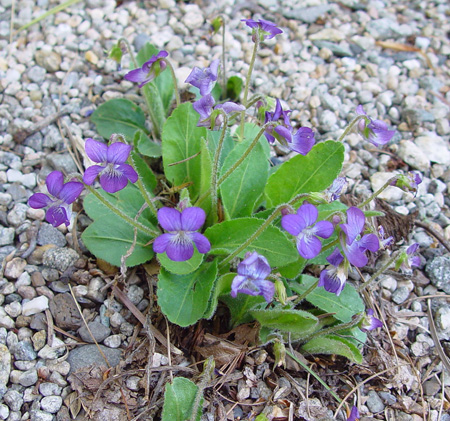
Chasmogamous flowering habit by Arthur Haines, Native Plant Trust
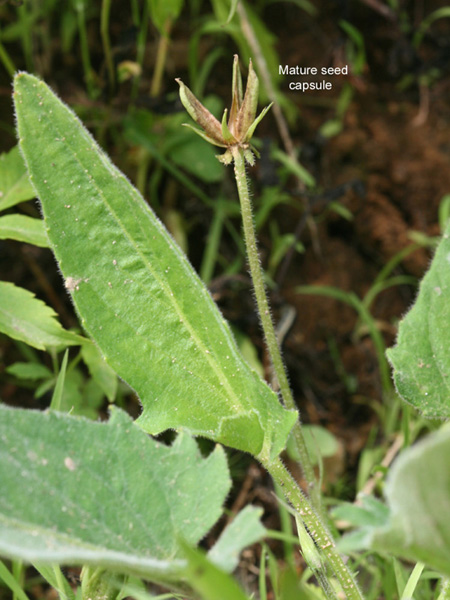
Cleistogamous fruiting habit by Arieh Tal, Native Plant Trust
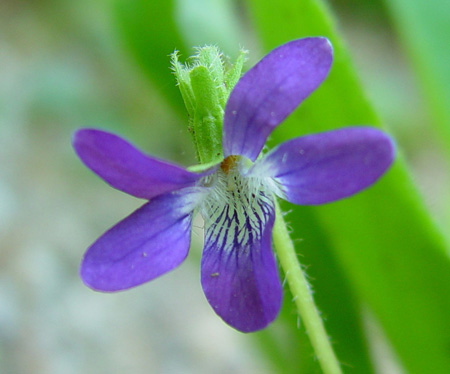
Chasmogamous flower front view by Arthur Haines, Native Plant Trust
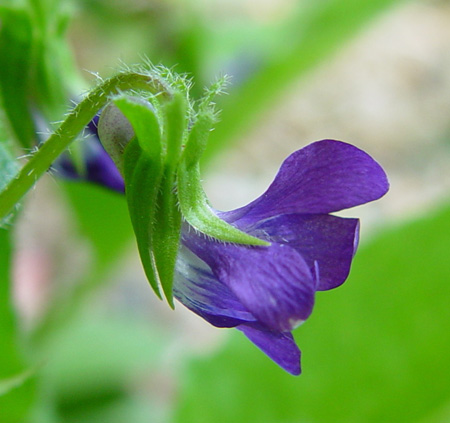
Chasmogamous flower profile view by Arthur Haines, Native Plant Trust
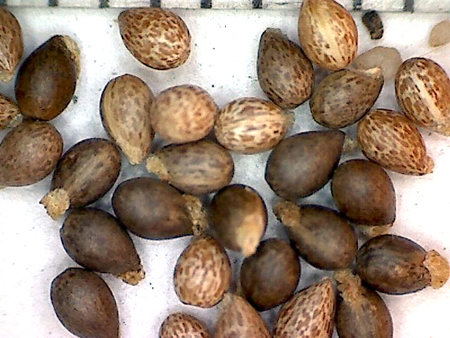
Seeds from herbarium specimen: MD, Riverdale, H. D. House 946 (NY)
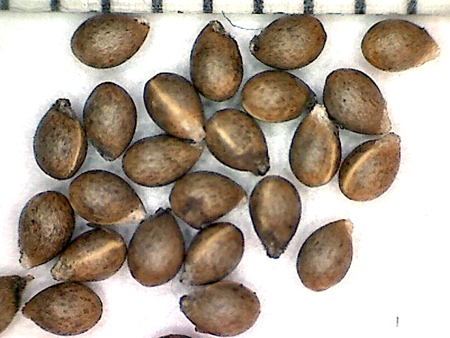
Seeds from herbarium specimen: Transplanted from OH, Guernsey Co., Blue Sky Road and Parker Road, H. Ballard 15-054W (BHO)
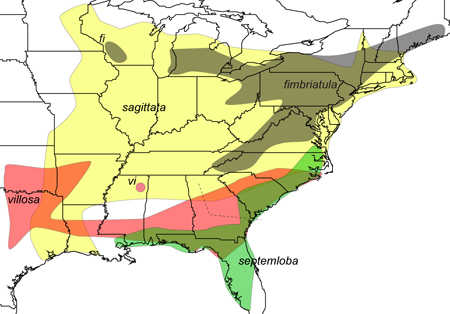
Map of Sagittata species group by Harvey Ballard